Chapter 1: Company Profile
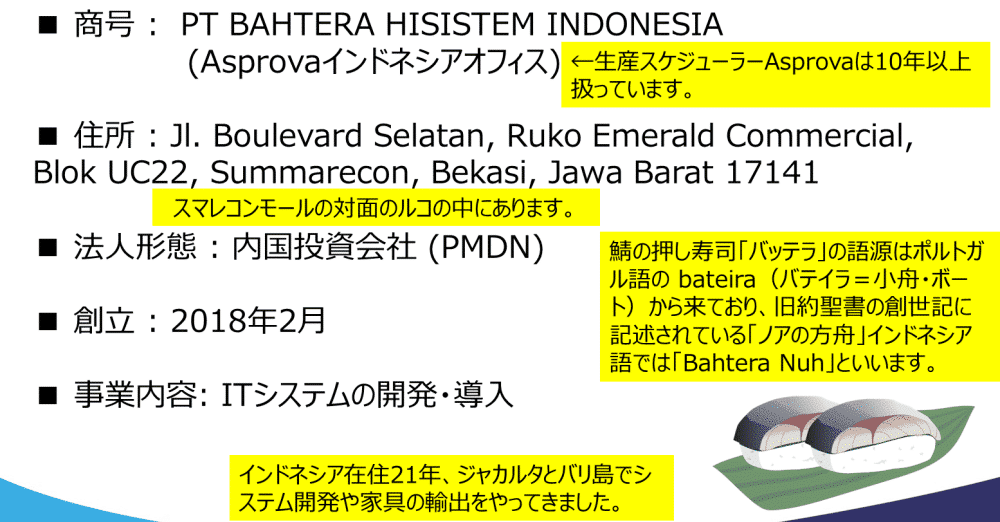
My name is Batera High System Yamamoto and I would like to thank you all for taking time out of your busy year-end schedule to visit our booth. Thank you for taking time out of your busy year-end schedule to attend this seminar.
In the first part of the presentation, Kuniet Corporation talked about "Improving Production Efficiency", and I would like to explain how to systematize it based on our experience and case studies.
First of all, I would like to give you a brief introduction of our company.
The company Batera High Systems is located in West Bekasi, past the outer ring highway, exiting Bekasi Barat and going to the left, there is a development area called Summarecon, where our office is located in Ruko.
During my previous job, I was in charge of installing the Asprova production scheduler for about 10 years, so I am working in my new company, Batera, as an Asprova representative, carrying the business card of "Asprova Indonesia Office".
I have been in Indonesia for 21 years and during that time I was engaged in system development and furniture exporting in Jakarta and Bali.
The word "Bahtera" in the company name comes from the Portuguese word "Battera" which means "mackerel sushi" and the Indonesian word "Bahtera Nuh" which means "Ark" in the famous Old Testament. The name is taken from this word.
- Improved data entry efficiency and accuracy
- Effective use of information through visualization, sharing and systematization
Once this is accomplished, information from the field will create a competitive advantage for the company.
In order to create a visible effect of the system implementation, we listen to the customer's requirements.
- How much better the business is now.
- What new results have been achieved?
Chapter 2: Challenges Facing Indonesian Factories in Recent Years
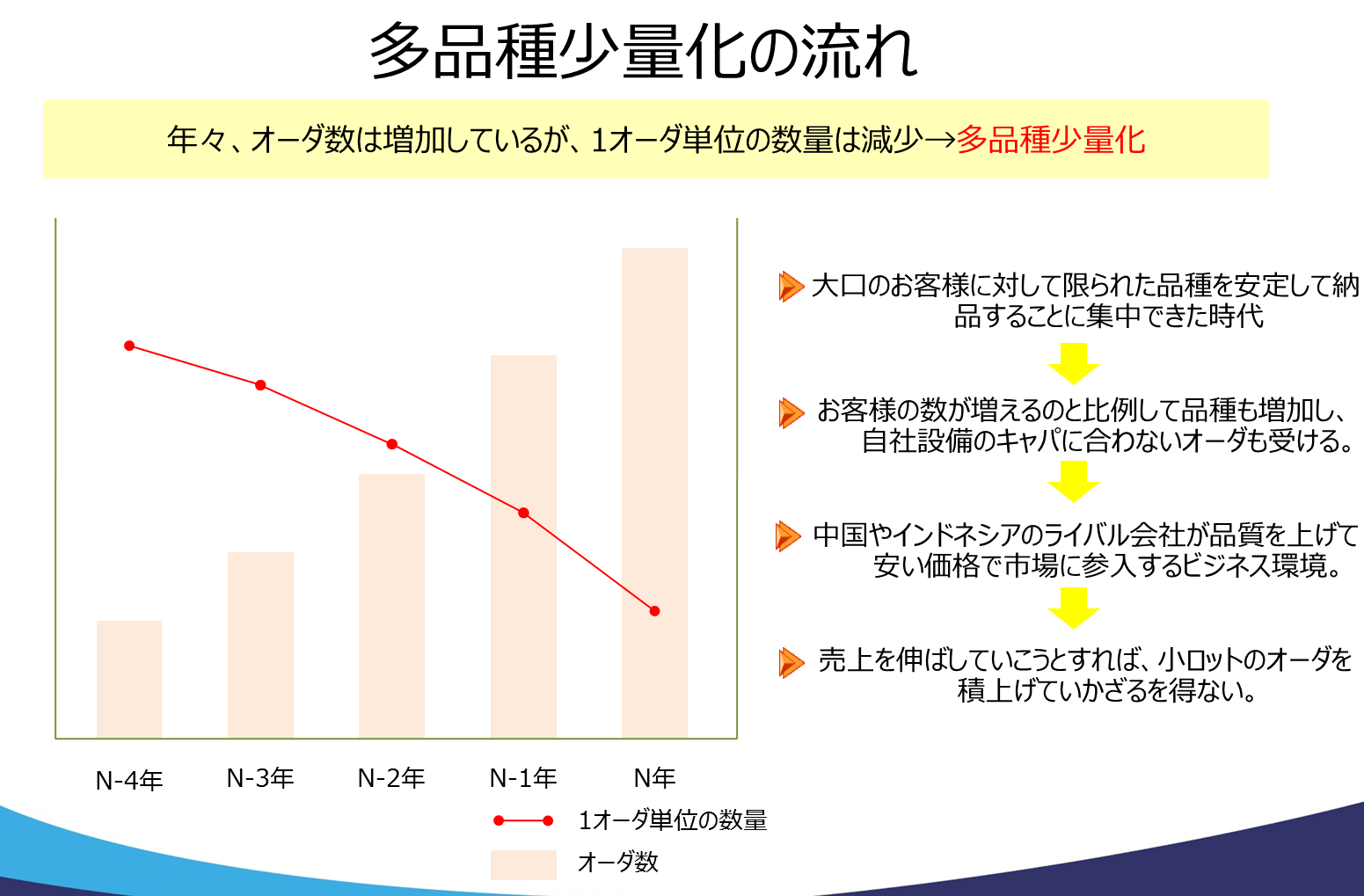
First, let's look at "Challenges facing Indonesian factories in recent years". Although those of you who are in close contact with our daily production may be more familiar with these issues than I am, I would like to focus mainly on the issues that are expected to be improved by systematizing the production planning and process control.
The trend toward high-mix low-volume production has been talked about for years.
However, rival companies in China and Indonesia are entering the market with higher quality and cheaper prices, and the business environment in Indonesia is becoming more and more difficult every year, so if we want to increase sales, we can't afford to do so, and we have no choice but to increase orders for small lots.
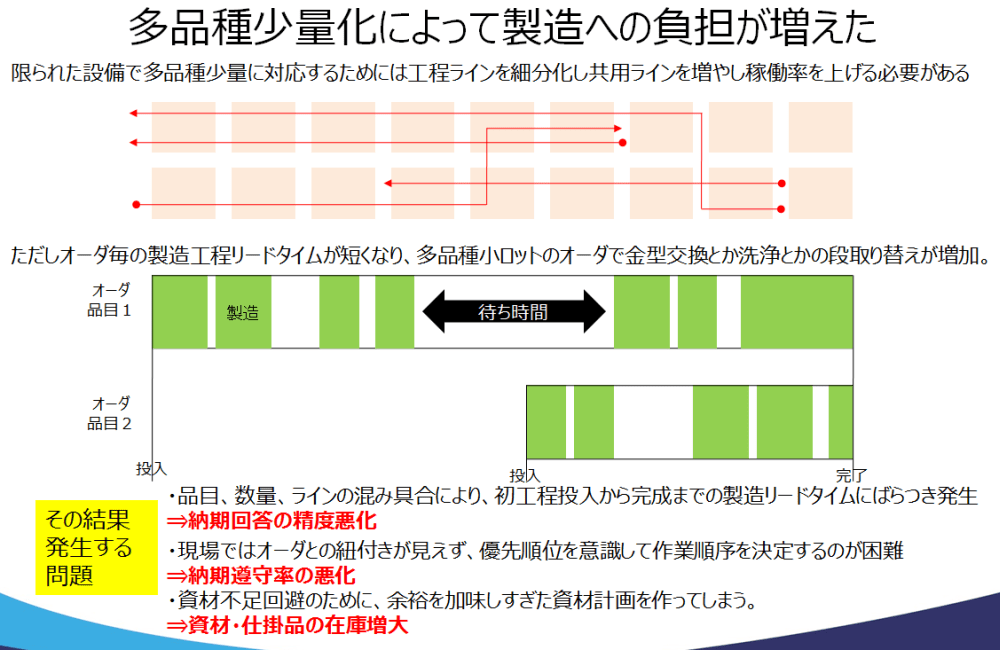
If we try to achieve high-mix low-volume production with limited facilities, we can divide the production line into smaller pieces and increase the number of shared lines to improve the overall operation rate.
However, small lots mean shorter lead times for each process, which inevitably leads to an increase in the number of setups such as mold changes and cleaning.
- Variation in the overall manufacturing lead time from first process input to completion makes it difficult to respond to delivery dates.
- The rate of meeting deadlines worsens because it is difficult to prioritize because it is difficult to see the link to orders in the field.
- Excessive inventory of materials and work in progress is caused by the need to avoid line stoppages due to material shortages.

The more customers we have, the more diverse our customers' circumstances will be, so we will have to deal with hardships that we did not have to deal with when we were engaged in production with the mission of providing a stable supply to our large customers.
- Variation in quantity
- Variation in delivery time
- express order interrupt
If these fluctuations occur upstream in the supply chain, a phenomenon called the bullwhip effect occurs, in which the range of fluctuation widens as you move downstream from production to purchasing.
The converse is also true: fluctuations in purchasing have a greater impact on upstream demand. I think there is also a reverse Bullwit effect, so to speak.
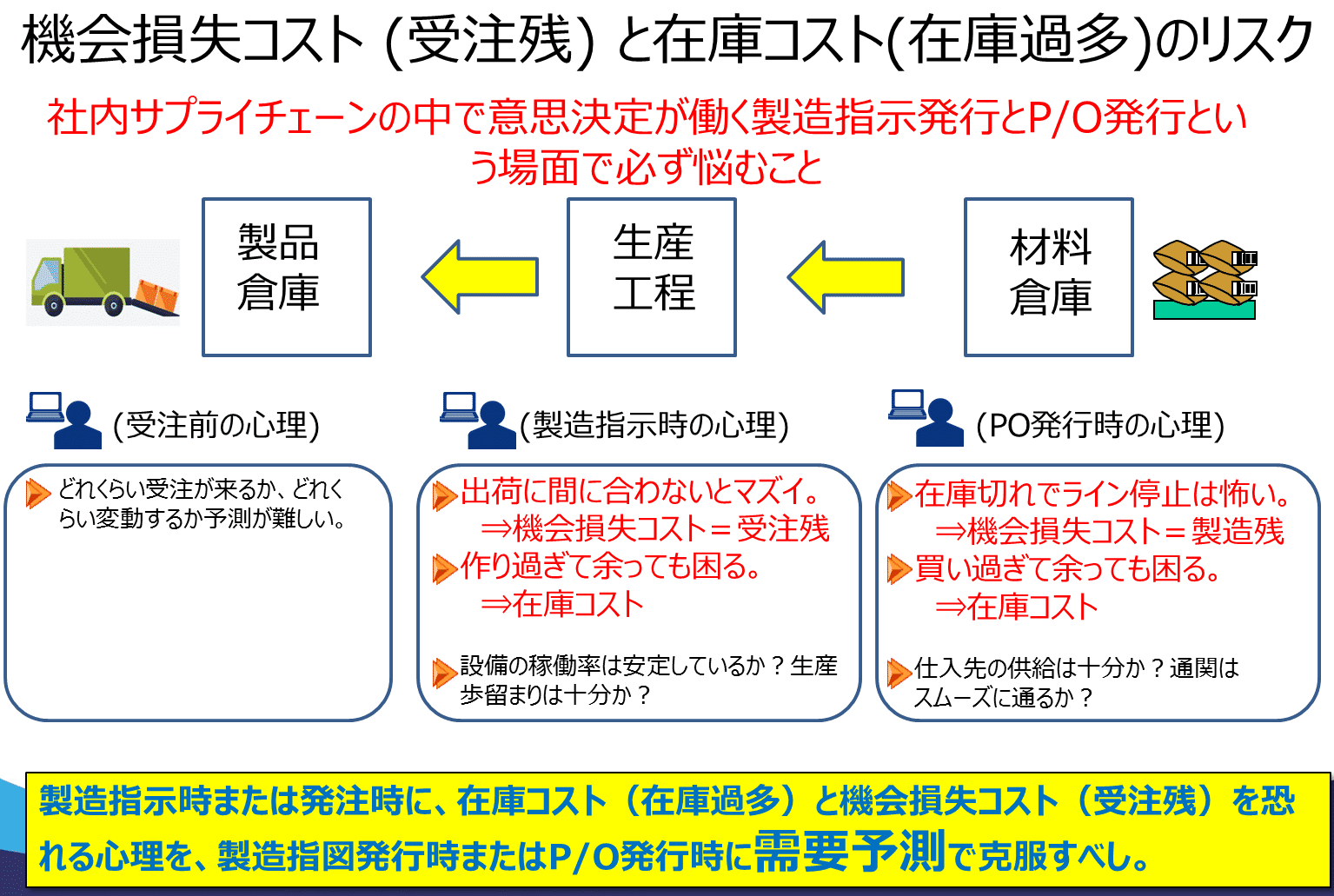
When we live in a world of high-mix low-volume production and when unofficial orders are given, the responsibility of decision-makers in factories becomes more and more important.
In a factory, the decision-making process in the supply chain involves "manufacturing instructions (how many units and when)" and "ordering (how many units and when).
In this important decision-making scene, the person in charge of the company considers two things: in the case of the manufacturing department
- We don't want to miss production for shipment.
- You don't want to make too much and have too much left over.
If you're in the purchasing department.
- We don't want to run out of materials in time for production.
- You don't want to buy too much material and have it pile up.
These are so-called opportunity cost and inventory cost, and although they are certainly difficult problems, they must be overcome, so I would venture to say positively that you should overcome the psychology of fearing inventory and opportunity cost at the time of manufacturing instructions or ordering by forecasting demand.
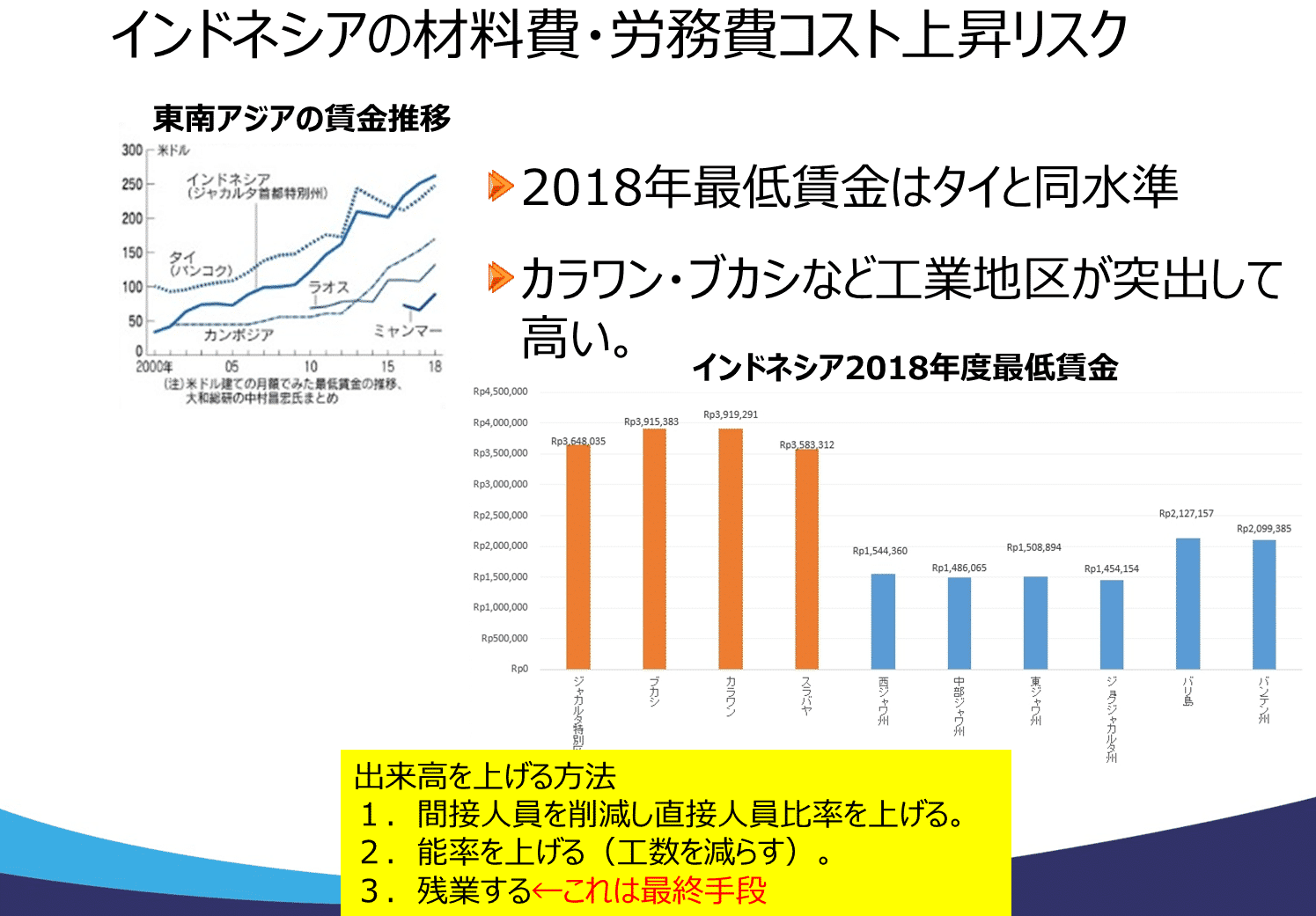
As you know, the minimum wage in 2018 is over 3.9 juta in Karawang Bekasi, and it is twice as high as Central Java, and it is not a mass employment train, but I think that it is understandable that people get off to Gambir station from the provinces to seek a job from not Ueno station but Gambir station.
There used to be a lot of ticket resale scalpers in the station before, but now the station building is newly built and there are stylish shops and cafes such as momoiro of siphon cake.
If the wage rate goes up when labor costs go up, the wage rate will go up, so if we try to keep up the volume we've had with the wage rate after the increase
- Increase the ratio of direct workers
- Increase efficiency (reduce man-hours)
- Working overtime - none because it's black
You will need to make an effort to reduce the ratio of indirect workforce or increase efficiency by improving operations.
Chapter 3: Time Saving and Inventory Reduction

Based on these risks, the business improvement is linked to the business improvement, and the specific policy to incorporate the business improvement into the system is described in Chapter 3. The policy for business improvement is determined based on the risks that we have seen in Chapter 2, and the policy for systematization is determined based on that policy.
Here, we can roughly divide the systems into two types: the process control system, which accumulates process results based on the current business improvement, and the production planning system, which formulates the future production plan. I think it is important to note that both systems are tools for achieving the goal of business improvement, not a means to an end.
Business systems such as process control, inventory control, sales control, and purchasing control are systems for partial optimization, and their purpose is to accurately record the management of quantities and time within a department.
However, in order to overcome the risks of demand fluctuations and interruptions in express orders that I mentioned earlier, partial optimization alone is not enough, so it is necessary to take a bird's-eye view of each department's operations and optimize the entire system in an integrated manner.

I mentioned earlier that one of the issues facing Indonesian factories in recent years has been the rise in labor costs. In the internal supply chain, from purchasing to manufacturing to shipping, time savings can add value in terms of time and internal resources.
However, this is not to say that we should just reduce time blindly. Even if the efficiency of the front-end process is improved, if the back-end process is not efficient enough to keep up with it, in-process inventory will increase. In other words, optimization in one department does not necessarily mean optimization for the whole company. This means that added value will not be increased.
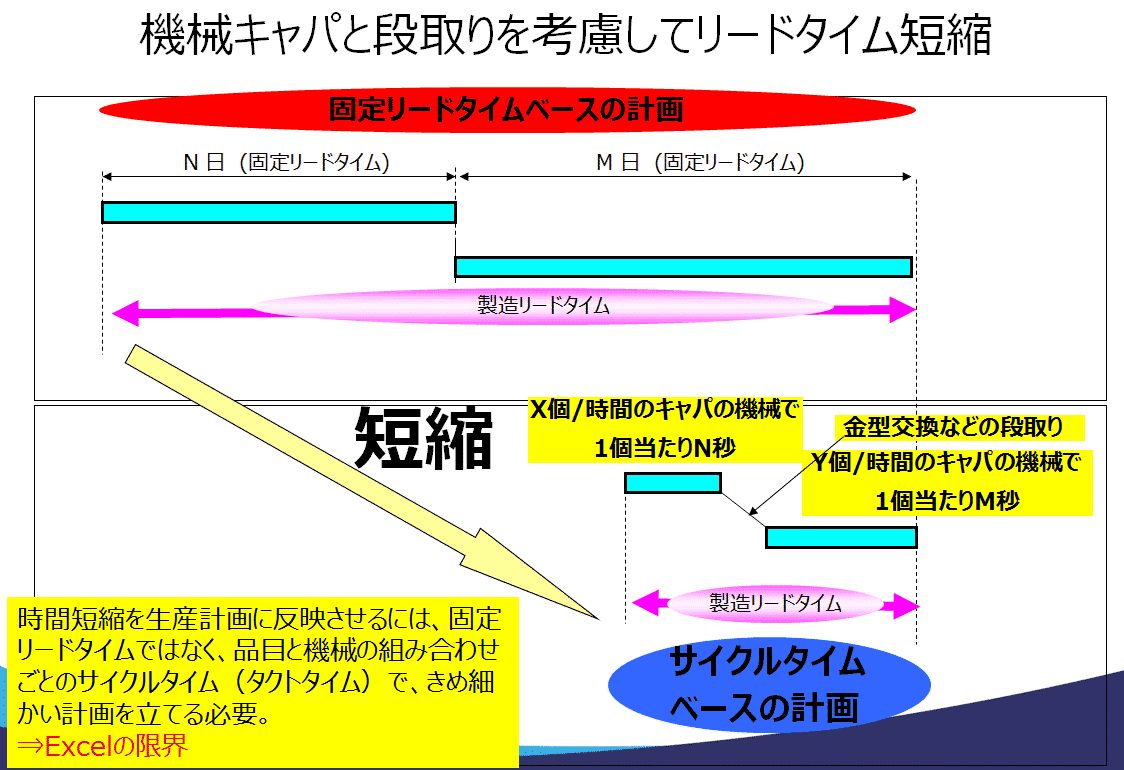
In order to reflect this time reduction at the stage of production planning, it is necessary to make detailed plans based on cycle time and tact time for each combination of items and machines, not based on a fixed lead time basis. In this case, the plan must take into account the machine capacity, which is the daily production capacity, and the setup of the machine, otherwise the plan will not be able to be carried out on site.
For example, it is necessary to reflect the constraint conditions in the production plan, such as "If the delivery date is within one week, the same item lot should be manufactured in succession". As we explore the optimization in this way, we realize that there is a limit to creating a production plan in Excel.

Next, we'll consider the proper inventory needed for overall optimization, but what is the purpose of having inventory in the first place? There are two reasons for having inventory.
- Insurance to avoid delivery delays due to the short lead time from order to shipment and the long manufacturing lead time from the start of production to the completion of production.
- Insurance to keep bottleneck processes from stopping production lines
It is common practice to hold two days' worth of inventory for shipments to prevent delivery delays, but the reason for not stopping the bottleneck process production line is because the takt time of the entire production depends on the takt time of the bottleneck process, so if the takt time of the bottleneck process is delayed, it affects the overall takt time, which in turn affects the yield.

Similar to the time savings mentioned earlier, the system can reflect this bottleneck process availability maximization by planning the bottleneck process first, then creating a plan with the front-end process backward and the back-end process forward and forward.
By first maximizing the operating rate of the bottleneck process and then planning the front and rear processes, you can create a production plan that minimizes the overall manufacturing lead time and maintains an appropriate inventory. By procuring only the materials necessary for production in line with the tact time of the bottleneck process and making them in line with the bottleneck, work-in-process inventory is reduced in the front-end process.
By shortening the time and maximizing the operating rate of the bottleneck process, appropriate inventory can be achieved, which means that cash can be made available for the amount of materials and work-in-process that have previously been built up in inventory. In addition, by delaying purchases to the point where they are required to match the tact time of the entire plant, we will be able to generate even more cash.
The process of business improvement will one day lead to these cash flow effects.
Chapter 4: A Case Study of Systematization with Total Optimization in Mind
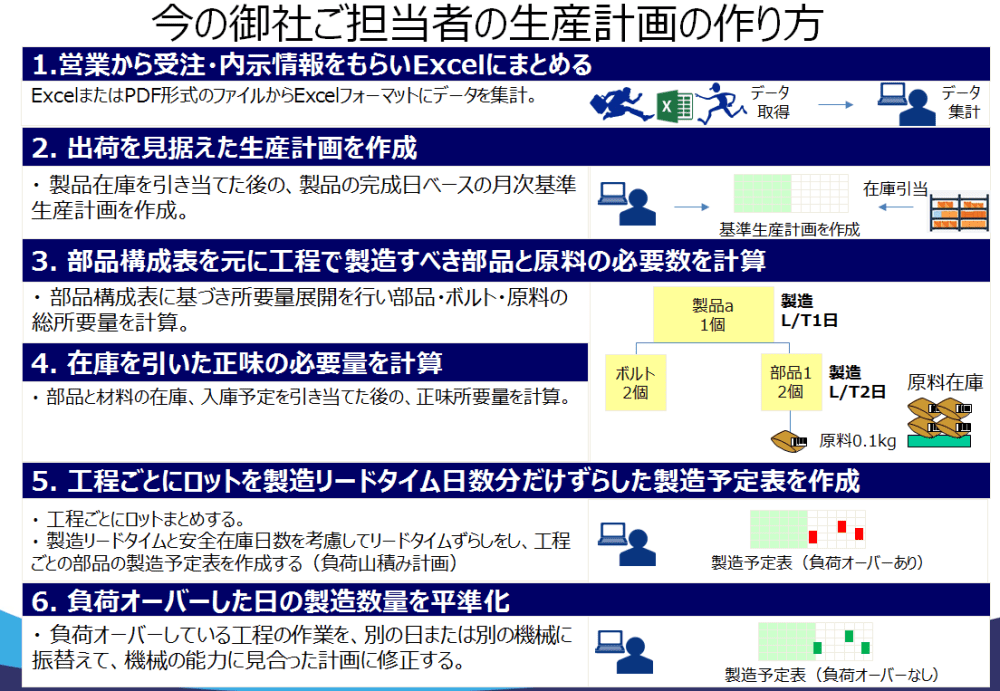
Here is an example of a system that implements the policy of overall optimization through "lead time reduction" and "proper inventory" that we have seen in the previous chapters. First of all, this is almost exactly how your current factory planners plan production.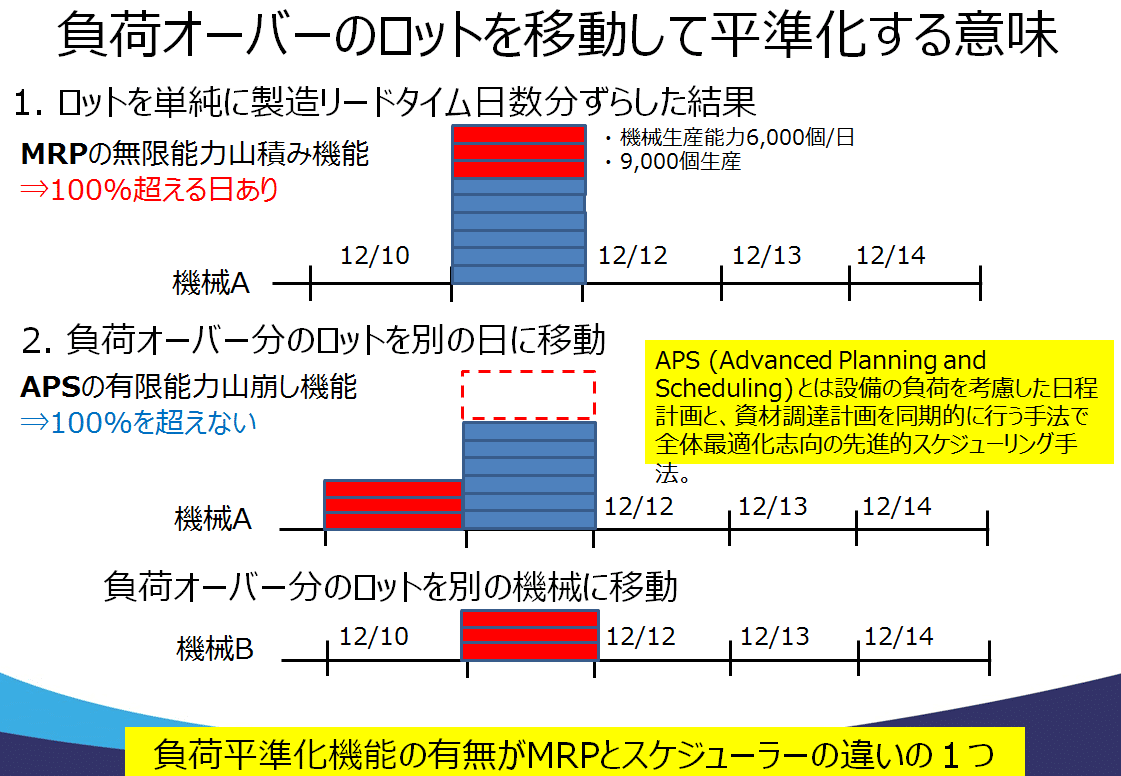
Shifting the lead time according to a fixed lead time is called infinite capacity piling, and since the capacity of the machine is assumed to be infinite, the lot will be 100% or more piled up on some days.
APS is a function that does this automatically, and it is a global optimization-oriented function that synchronizes production planning and purchasing and procurement planning that takes machine load into account.
There are two problems with the way production planning is often done in Indonesia: One is that the production planning is done with a view to shipping to meet the customer's needs, but the PPIC personnel tend to create plans at their own discretion, looking only at the manufacturing site, which tends to result in partial optimization. This results in the following problems
- It takes time for the sales team to report the status to the customer and to reply to the customer on time.
- It takes time to change order quantities and delivery dates and to respond to express orders.
The second is that lead time shifting and load leveling are carried out separately for each process. If lot sizing is performed without considering the production capacity and load conditions of the processes before and after, and load leveling is performed based on the results of simple manufacturing lead time shifting, partial optimization is likely to occur, which may result in the post-process not being able to respond in time, increasing waiting time and inventory.
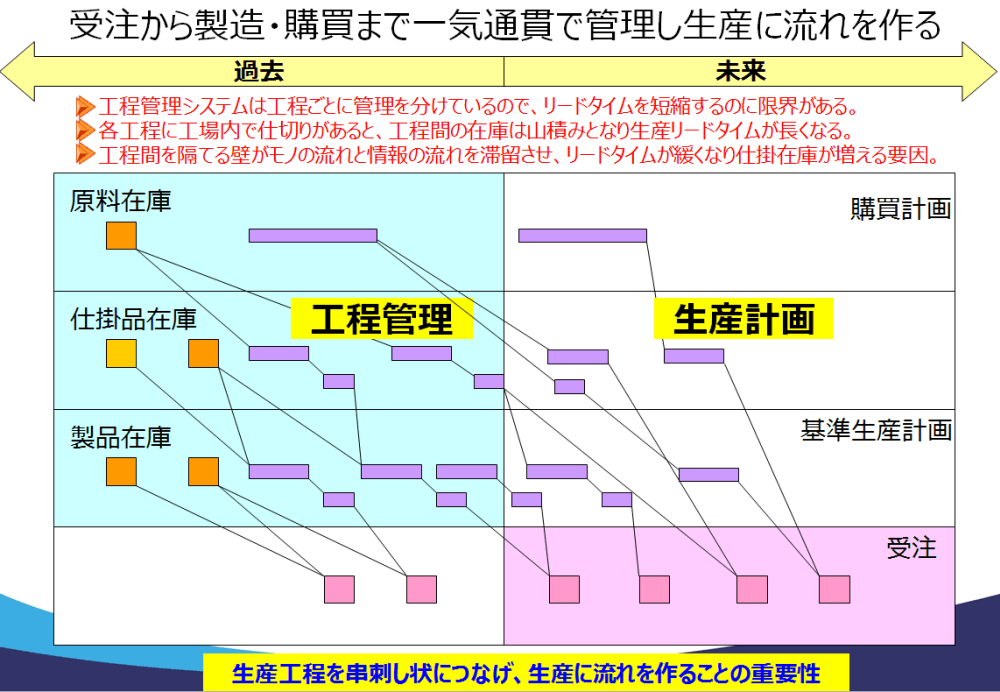
By linking order information from sales and the PPC department's production plan, you can create a flow of production, shorten the lead time and prevent inventory bottlenecks by visualizing order, manufacturing and purchasing in a skewer-like manner.

The limitation of manual work in Excel is that, after setting the working days of the previous process based on the standard production plan by staggering the lead time, if the capacity of the equipment exceeds the capacity, the work is moved forward or moved to another equipment.

At the Cikarang plant, the Cikarang plant automatically creates a standard production plan taking into account product inventory based on order information from sales, imports the item, order quantity and order delivery date into the Asprova production scheduler, and at the same time as the parts are deployed, performs cycle time based lead time shifting and automatically equalizes work on days when equipment capacity is overflowing.
Actual data input from the processes is done in Excel, which the operators are familiar with, and after each shift is over, the data is uploaded from each line terminal to a predetermined folder on the server and processed by the system to become actual data in Asprova.



